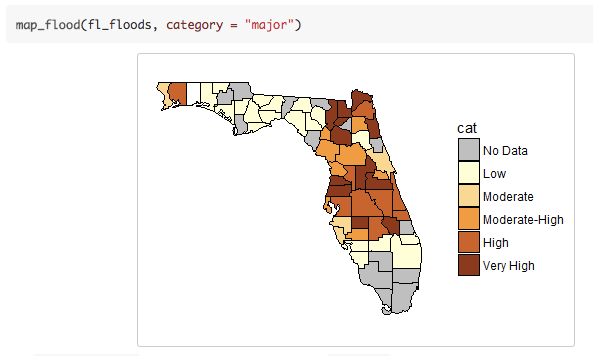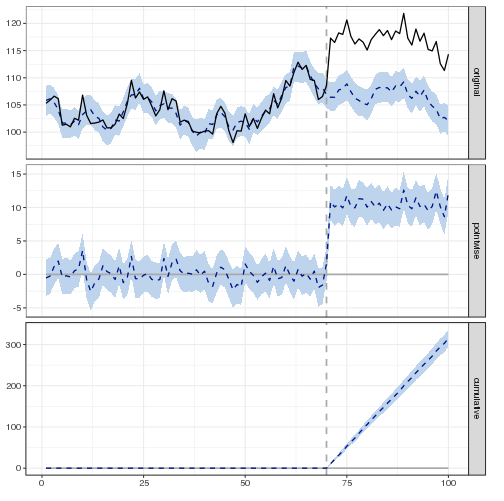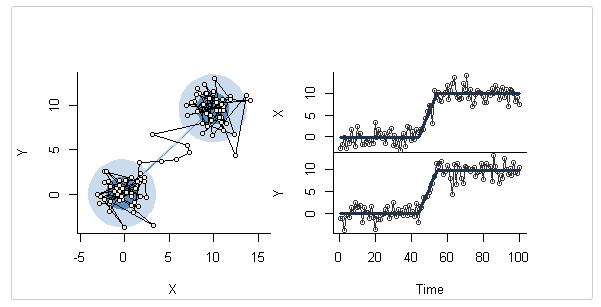Here are my picks for the “Top 40” new packages submitted to CRAN in April 2017. These selections, which were culled from 208 submissions, are organized into four categories: Data, Finance, Statistics and Utilities. The number of entries in the Data and Utilities categories reflect the initiatives of R developers to connect to external resources.
Data
comtradr v0.0.1: Provides functions to extract country-level shipping data for a variety of commodities data from the United Nations Comtrade API.
countyfloods v0.0.2: Provides access to county-level United States flood data using United States Geological Service (USGS) API. The vignette provides examples.

EdSurvey v1.0.6: Provides functions to access and analyze survey and assessment data from the National Center for Education Statistics (NCES), including the National Assessment of Educational Progress (NAEP. There are is an Introduction, and vignettes for Advanced Data Manipilation, NAEP Accommodations, Statistical Methods, and Achievement Levels.
RNRCS v0.1.1: Provides functions to download data from the Natural Resources Conservation Service (NRCS) for sites in the Soil Climate Analysis Network (SCAN), and Snow Telemetry (SNOTEL and SNOLITE) networks. Metadata can be returned for all sites in the NRCS’ Air and Water Data Base (AWDB).
roadoi v0.2: Implements a web client interface to oaDOI, a service providing free full-text access to academic papers through various sources including Crossref, Bielefeld Academic Search Engine (BASE), and the Directory of Open Access Journals (DOAJ). The vignette shows how to use it.
rsoi v0.2.1: Provides functions to download Southern Oscillation Index data and Oceanic Nino Index data from NOAA.
rsolr v0.0.4: Implements an API for querying Apache Solr databases. There is a vignette.
tubern v0.1.0: Implements an R client for the YouTube Analytics and Reporting API. The vignette shows how to use the API.
wikitaxa v0.1.4: Provides access to taxonomic information from Wikipedia, Wikicommons, Wikispecies, and Wikidata. There is a vignette.
Finance
partialCI v1.1.0: Provides functions for estimating, testing, and simulating partially cointegrated time series. Clegg et al. provide an in-depth discussion of the package functionality, as well as illustrating examples in the fields of finance and macroeconomics. The vignette provides a guide to the package.
PortfolioOptim v1.0.3: Provides two functions for financial portfolio optimization by linear programming.
Statistics
bigKRLS v1.5.2: Provides functions for Kernel-Regularized Least Squares that are optimized for speed and memory usage. The author’s website has sample code and more. A vignette shows the basics.
brglm2 v0.1.4: Provides functions for achieving bias reduction in Generalized Linear Models via solving the mean bias-reducing adjusted score equations in Firth and Kosmidis and Firth, or the median bias-reduction adjusted score equations in Kenne et al., or through the direct subtraction of an estimate of the bias of the maximum likelihood estimator from the maximum likelihood estimates as in Cordeiro and McCullagh. There are vignettes on bias reduction and on Detecting Separation.
casebase v0.1.0: Implements the case-base sampling approach of Hanley and Miettinen, Saarela and Arjas, and Saarela, for fitting flexible hazard regression models to survival data with single event type or multiple competing causes via logistic and multinomial regression. There are vignettes on Competing Risk Analysis, Population Time Plots, and Casebase Sampling.
CausalImpact v1.2.0: Implements a Bayesian approach to causal impact estimation in time series, as described in Brodersen et al. Look here to get started, and also at the vignette.
 To estimate a causal effect, specify which period causal should be used for training the model (pre-intervention period), and which period for computing a counterfactual prediction (post-intervention period).
To estimate a causal effect, specify which period causal should be used for training the model (pre-intervention period), and which period for computing a counterfactual prediction (post-intervention period).
ggeffects v0.1.0: Provides functions to compute marginal effects at the mean or average marginal effects from statistical models, and returns the result as tidy data frames. The vignette shows how to use it.
glmnetUtils v1.0.2: Provides a formula interface for the glmnet package. The vignette shows how to use it.
lspline v1.0-0: Implements linear splines with convenient parameterizations such that (1) coefficients are slopes of consecutive segments, or (2) coefficients are slope changes at consecutive knots. The vignette gives examples.
marcher v0.0-2: Provides tools for likelihood-based estimation, model selection, and testing of two- and three-range shift and migration models for animal movement data as described in Gurarie et al.. The vignette shows how to use the model and create visualizations.

Simulation of Range Shift Processes
Meiosis v1.0.2: Provides tools for simulation of meiosis in plant breeding research. There is a vignette.
MultiVarSel v1.0: Implements a novel variable selection approach in the multivariate framework of the general linear model, taking into account the dependence that may exist between the columns of the observations matrix. For details, see the paper Perrot-Dockes et al.. The vignette shows an example.
mrbsizeR v1.0.1: Implements a method for the multiresolution analysis of spatial fields and images to capture scale-dependent features based on scale space smoothing. The vignette provides an example.
networktools v1.0.0: Includes assorted tools for network analysis, including functions for calculating impact statistics (global strength impact, network structure impact, edge impact), and for calculating and visualizing expected influence. The vignette describes the impact statistics.
philentropy v0.3.3: Provides functions to compute forty-six optimized distance and similarity measures for comparing probability functions that are useful in a broad range of scientific disciplines. There is an Introduction and vignettes for Distances Measures and Information Theory.
plink v1.5-1: Provides functions to facilitate the linking of mixed-format tests for multiple groups under a common item design using unidimensional and multidimensional IRT-based methods. The very thorough vignette presents the theory.
RLT v3.1.0: Random forest with a variety of additional features for regression, classification, and survival analysis.
spup v0.1-0: Implements for analyzing uncertainty propagation in spatial environmental modeling using the methodologies of Heuvelink et al. and Brown and Heuvelink. There are vignettes on spatially cross-correlated variables, spatially variable sd, uncertainty propagation, and categorical variables.
Utilities
ajv v1.0.0: Provides a thin wrapper around the ajv JSON validation package for JavaScript. There is a vignette to get you started.
aws.s3 v.3.1: Implements a simple client package for the Amazon Web Services (AWS) Simple Storage Service (S3) REST API.
cranlike v1.0.0: Provides a set of functions to manage ‘CRAN’-like repositories efficiently.
d3Tree v0.1.0: Provides functions to create and customize interactive collapsible ‘D3’ trees using the D3 JavaScript library and the htmlwidgets package, which can be used directly from the R console, from RStudio, in Shiny apps, and in R Markdown documents. Look here for examples.
library(d3Tree)
d3tree(list(root = df2tree(rootname = 'book',
struct = stan.models),
layout = 'collapse'))dataMeta v0.1.0: Provides functions to create a basic data dictionary and append it to the original dataset’s attributes list. The vignette shows how it works.
dparser v0.1.3: Implements a scannerless GLR parser based on the Tomita algorithm.
glue v1.0.0: Provides an implementation of interpreted string literals, inspired by Python’s Literal String Interpolation, Docstrings, and Julia’s Triple-Quoted String Literals. The README shows how they work.
icosa v0.98.1: Employs triangular tessellation to refine icosahedra defined in 3D space. The vignette provides the details.
leaflet.minicharts v0.2.0: Allows users to add and modify small charts on interactive maps created with the leaflet package
RcppQuantuccia v0.0.1: Provides QuantLib bindings for R using ‘Rcpp’ and the header-only Quantuccia variant.
shinymaterial v0.2.1: Allows shiny developers to incorporate UI elements based on Google’s Material Design. See the package website more information.
unitizer v1.4-2: Provides functions to simplify regression tests by comparing objects produced by test code with earlier versions of those same objects. There is an Introduction, and vignettes for the interactive environment, Reproductble Tests, unitizeR details, and Miscellanea.
unix v1.3: Provides bindings to various Unix system utilities.
You may leave a comment below or discuss the post in the forum community.rstudio.com.